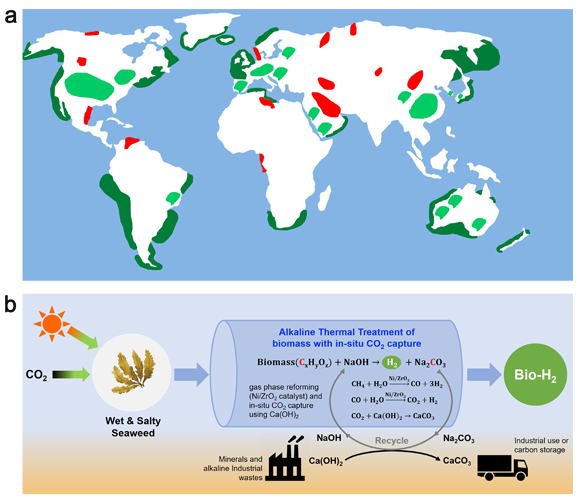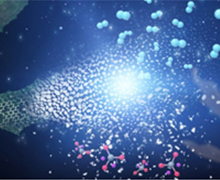본문
High-purity hydrogen production from renewable seaweed biomass with carbon capture and storage potential
By Prof. Woo-Jae Kim (wjkim1974@ewha.ac.kr)
Department of Chemical Engineering and Materials Science
Given the rapid development of the global economy and ever-increasing population, the world’s energy demand will increase by 30% by 2040 according to the International Energy Agency (IEA).1 Global CO2 emissions from energy use are expected to increase up to 35.7 GT per year, which is far from the necessary level required to avoid severe climate change.23 Thus, further use of renewable low-carbon and carbon-neutral energy sources (e.g., solar photovoltaic, wind, hydropower, and biomass) is urgently needed.45
H2 has a high energy density and is the only carbon-free energy carrier compared to conventional fuels. With the emerging market of fuel cell vehicles, H2 is also increasing in demand. At present, it is mainly produced from fossil sources leading to inevitable CO2 emissions. That is, with current thermochemical methods to generate H2 including gasification and steam reforming of coal and natural gas, anthropogenic CO2 emission is inevitable. However, a truly transformative scheme of H2 production should be renewable and carbon-neutral. Biomass is a carbon-neutral energy source, absorbing CO2 from atmosphere through photosynthesis, and can be even carbon-negative when combined with carbon capture and storage.
If biomass is used as a source of H2, the process can be considered carbon-neutral. Particularly, seaweed is a unique aquatic biomass that does not compete for land or fresh water. Its use as an energy source is not well studied and its high moisture and salt contents will be challenging if used in conventional biomass conversion processes. Unfortunately, reaction pathways to thermochemically convert salty and wet biomass into H2 are limited.
To address these challenges, we developed a novel catalytic alkaline thermal treatment (ATT) of seaweed, which can innovatively produce high purity H2 from wet and salty biomass feedstock with substantially suppressed CO2 formation, making the overall biomass conversion not only carbon-neutral but also potentially carbon-negative
We recently demonstrated that high-purity 1.57 L H2 is produced from 1 g of brown seaweed with a conversion as high as 71%, which is considerably greater than those reported in the literature.6 ATT can simplify reaction pathways to produce only H2, while conventional gasification reaction generates various gas products, including CO, CO2, and various hydrocarbons. The ATT also captures CO2 as solid carbonates (therefore, doesn’t produce any green house gas) as well as fragments the biomass to produce high purity H2, working together with reforming catalysts. By in-situ capturing CO2 and regenerating the hydroxide via mineral carbonation, this bio-H2 production technology has shown a great BioEnergy with Carbon Capture and Storage (BECCS) potential.
This study provides insights into the future deployment of carbon-negative H2 production from unconventional biomass sources such as seaweed, food waste, and algae, which are often high in water and salt contents.

Figure 1. Distributed unconventional biomass resources and a reaction pathway to bio-hydrogen with carbon capture. a Global distribution of seaweed (green) and algae (light green) compared to major oil reserves (red). b Alkaline thermal treatment (ATT) of seaweed innovatively produces high purity bio-H2 from wet and salty biomass feedstock with a carbon capture and storage potential. Seaweed absorbs CO2 from atmosphere and stores the solar energy through photosynthesis without needing fresh water. The catalytic ATT involves the conversion of seaweeds in the presence of hydroxide and gas phase reforming catalyst. The overall reaction leads to bio-H2 as the carbon-free energy carrier, while carbon in biomass is stored as solid carbonate.

* Related Article
Zhang, K., Kim, W.-J., Park, A.-H., Alkaline thermal treatment of seaweed for high-purity hydrogen production with carbon capture and storage potential, Nature Communications, 11, 3783 (2020)
* References
1. IEA. International Energy Agency in World Energy Outlook (2018).
2. Chu, S., Cui, Y. & Liu, N. The path towards sustainable energy. Nat. Mater. 16, 16 (2017).
3. BP., BP Statistical Review of World Energy (2017).
4. Chu, S. & Majumdar, A. Opportunities and challenges for a sustainable energy future. Nature 488, 294 (2012).
5. Sikarwar, V. S. et al. An overview of advances in biomass gasification. Energy Environ. Sci. 9, 2939–2977 (2016).
